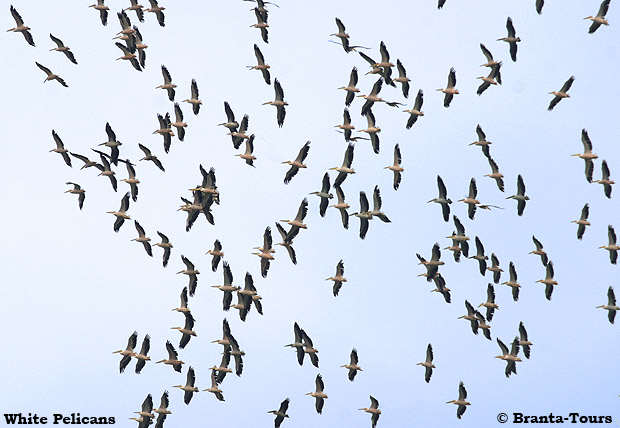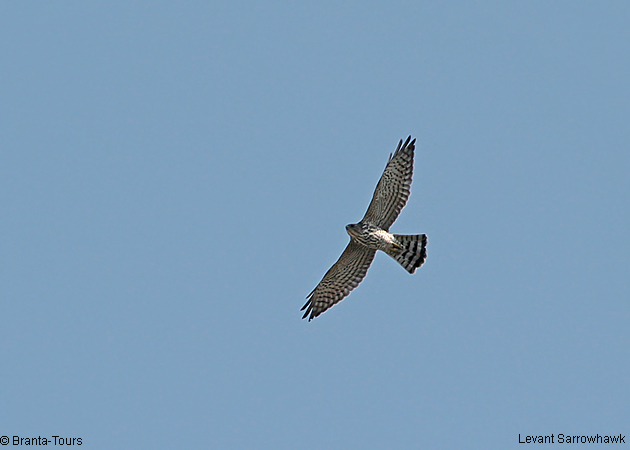


















|
Autumn migration Via Pontica flyway Description: This exciting tour to the western coastal
zone of the Black Sea features one of the most pronounced movements of
migratory birds occurring in Europe. The famed passage of raptors and
storks over the Bosporus is fed by a concentrated corridor of birds funnelling
along the Bulgarian coast (known as the 'Via Pontica' flyway). Lesser Spotted, Short-toed and Booted Eagles, Steppe, Long-legged and Honey Buzzards, four species of harrier, Levant Sparrowhawk, Saker and Red-footed Falcons are among the large cast of appetising raptors - lots of opportunity to hone your ID skills. White and Black Storks, Dalmatian and White Pelicans also soar overhead, while Pygmy Cormorant, Great Egret and other herons, Spoonbill, Glossy Ibis and Crane are some of the highlights of wetlands visited. Just about anything is possible on the wader front - Marsh and Broad-billed Sandpipers are regular - and small passerines often pass through in droves; Ruddy Shelduck and Ferruginous Duck are notable wildfowl. 
But the tour isn't just about birds. We shall also try to find mammals (including three marine species), of which Jackal, Marbled and Steppe Polecats, Romanian Hamster and European Souslik are of particular interest. To this end we embark on our well-tested and highly successful spotlighting sorties after dark - a very popular and addictive activity. We may also encounter amphibians and reptiles - Eastern Spadefoot (toad), Stripe-necked Terrapin, Balkan Wall and European legless Lizard, Reddish Whip, Leopard and Four-lined Snakes - and late wild flowers will doubtless inspire interest. We visit some of the most important wetlands in Europe, unspoiled dunes
and beaches, pristine steppe habitats and wooded valleys, at a time when
visitors are few and the azure blue waters of the Black Sea may be enjoyed
in the warmth of early autumn sunshine. Itinerary 
Days 6 & 7: Today's exploration of nearby Lake Atanosovsko
and surrounding saltpans promises a phenomenal range and quantity of birds
- far too numerous to list! This is Bulgaria's premier bird location -
in fact one of Europe's principal 'hot spots' - where just about any European
wader can turn up including Terek, Marsh and Broad-billed Sandpipers, and scene of an awesome spectacle of raptor passage.
In addition to species already seen we may with luck add Imperial, Spotted
and Steppe Eagles, Pallid Harrier and Saker. Cranes are also present in their thousands. |
Birding in Azerbaijan ::
Spring Birdwatching ::
Central Siberia ::
Hungary in Spring ::
Spring Bulgaria Birding ::
Spring Birdwatching ::
Birding in Bulgaria ::
Autumn Migration ::
Red-breasted Goose ::
Winter Tour ::
Fortnight Spring Birdwatching ::
Bulgaria & Romania Tour
Russian Far East :: Corsica :: Twelve Days Intensive Birding :: Natural History Tour :: ALBENA Birding Holidays :: Spring Botany :: Red Breasted Goose :: Spring Birdlife and Brown Bears :: Wildlife Photo Tours
Home ::
Company ::
Tours ::
Tour-info ::
Gallery ::
Articles ::
Contacts ::
Links ::
Latest news ::
Trip-reports ::
Bulgaria ::
Romania ::
Belarus ::
Russia ::
Sightings ::
Bookings
All rights reserved.
|